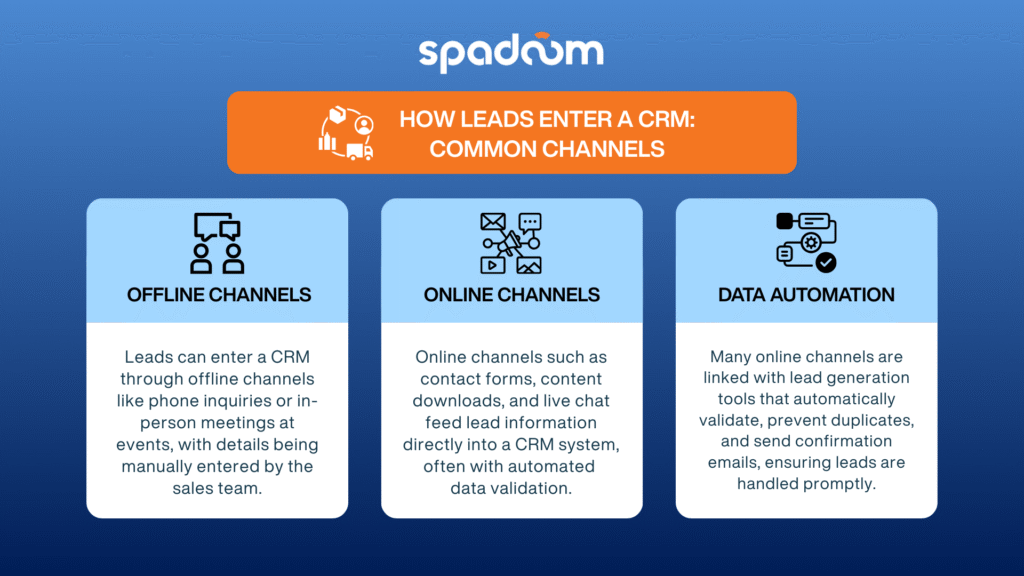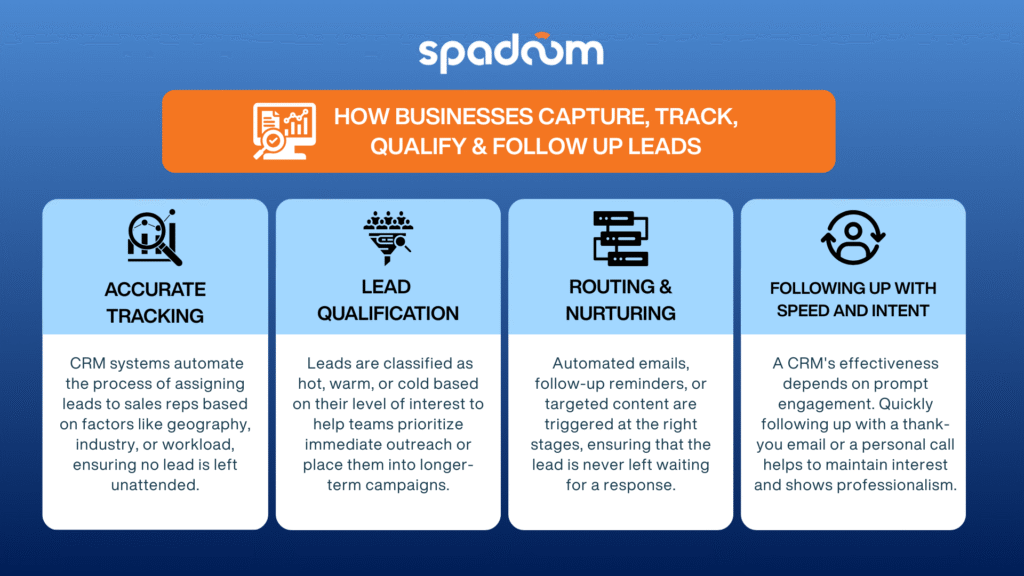You’re at a trade fair, and someone stops by your booth to ask about your product. Later that day, another person visits your website and fills out a demo request form. In both cases, you now have a potential customer, but without a clear system in place, it is easy for those contacts to be forgotten.
Within a CRM, these individuals are defined as leads: people who have shown interest or potential to buy, whose details and interactions are recorded so they can be tracked and followed up with effectively.
Why does this matter? Because even when people take the time to reach out, many businesses fail to treat them as leads. Around 25% of online leads never end up speaking with a salesperson, which means genuine interest is often lost before it is acted upon.
When a contact is not captured and managed within a structured process, the chance to build a relationship and eventually close a sale can disappear. Capturing and tracking leads is therefore not only about storing data but also about ensuring every interaction has the potential to move forward.
In today’s blog, we’ll look closely at what a lead in CRM actually means, how different kinds of leads enter a system, and how businesses capture and track them in ways that turn early interest into consistent revenue growth.
What Exactly Is a Lead in CRM and Why It Matters
In everyday business conversations, the term “lead” is often confused with words like “prospect” or “opportunity.” In a CRM, however, each one has a specific meaning.
A lead is any individual or organization that has shown initial interest in your product or service, but who has not yet been qualified. A prospect is a lead that has been assessed and meets certain criteria, while an opportunity is a qualified prospect that is actively being worked toward a potential deal.
Making these distinctions clear ensures that genuine opportunities aren’t buried under noise, and that sales energy is directed toward deals with the highest chance of closing.
So, what qualifies someone as a lead? It can be as straightforward as filling out a demo request form on your website, dropping a business card at a trade fair, calling to ask about pricing, or responding to an email campaign. Whether online or offline, the moment someone provides details that indicate interest, they become a lead worth recording.
This is where the CRM system plays its central role. A CRM is the software businesses use to store these details, track every touchpoint, and move leads through the stages of engagement until they are ready for sales.
When lead management is handled through a structured system, the impact on performance is significant. Companies using CRM systems often see conversion rates increase by as much as 300%, showing how effective organization and follow-up can directly translate into more closed deals.
How Leads Enter A CRM: Common Channels
Leads can enter a CRM through many different paths, and businesses often use a mix of offline and online channels to capture them.

On the offline side, a common example is a phone inquiry. A potential customer might call to ask about availability or pricing, and the details are then entered into the CRM manually by the sales team.
In-person meetings also fall into this category. For instance, if a sales representative meets someone at a local networking session and collects their details, those details should be recorded in the CRM so the interaction is not lost.
Online channels create even more opportunities for lead capture. Contact forms, content downloads such as white papers, webinar registrations, or signups through live chat all feed information directly into a CRM.
Many of these channels can be linked with lead generation tools that automatically validate the data, prevent duplicates, and send confirmation emails. This automation not only saves time but also ensures that the sales team receives leads while interest is still fresh.
How Businesses Capture, Track, Qualify & Follow Up Leads
A lead’s journey through a CRM involves several stages that work together to move interest toward action. Businesses must capture data accurately, qualify leads with clear criteria, route them to the right people, and follow up at the right time to keep momentum alive.

Tracking
Businesses need accurate tracking to understand every lead’s journey. At a minimum, this includes contact details, the source or channel, the date of entry, and behavioral signals such as email opens or website visits. Modern CRM platforms often provide built-in analytics to capture these touchpoints, giving sales teams a clear view of activity.
Tools like HubSpot CRM go further by automating the collection of engagement data, ensuring nothing is overlooked. Reliable tracking means businesses can identify which channels deliver the most qualified interest and refine their outreach accordingly.
Qualification & Lead Scoring
Not every lead is equal, which is why qualification and lead scoring play a central role. A strong system evaluates factors such as company size, job title, expressed interest, and specific behaviors like repeated site visits. Scoring helps teams focus on leads most likely to convert rather than chasing every new contact.
Platforms like ActiveCampaign provide automated scoring systems that assign points based on actions such as email opens, link clicks, website visits, or form submissions, ensuring the most engaged leads rise to the top. Driftrock reports that businesses using lead scoring see a 77% increase in ROI from lead generation, a clear sign that prioritizing quality over volume pays off.
Routing and Nurturing Leads
Once leads are captured and scored, the next challenge is making sure they are handled properly. Routing decides who should take ownership of the lead, while nurturing determines how the relationship is developed over time.
Many CRM systems automate this process by assigning leads to sales representatives based on geography, industry, or workload. This ensures no lead is left unattended and that the right person engages from the start.
Segmentation then sharpens the process further. Leads may be classified as hot, warm, or cold depending on their level of interest, which helps teams decide whether to prioritize immediate outreach or place them into longer-term campaigns.
From there, structured workflows keep momentum going. Automated emails, follow-up reminders, or targeted content are triggered at the right stages, making sure the lead is never left waiting.
The payoff of this structured approach is significant. BeBusinessed reports that strong lead nurturing generates 50% more sales-ready leads at 33% lower cost, showing that consistent engagement not only builds trust but also makes the entire sales process more efficient.
Following Up With Speed and Intent
The effectiveness of a CRM still depends on how quickly and thoughtfully leads are engaged. A prompt thank-you email after a demo request signals professionalism, and a short qualification call helps clarify needs early.
Leads collected through direct contact are most valuable when acknowledged quickly and personally. Reaching out within a day or two and providing a clear reason to continue the discussion helps maintain interest and signals reliability.
By combining speed with meaningful communication, businesses increase the chances that a curious contact becomes a committed customer.
How Spadoom Strengthens Your Lead Management with SAP CRM
At Spadoom, we help businesses structure their CRM environments to capture, organize, and act on leads with precision. From setting up lead scoring rules to integrating reliable data capture tools, our team ensures your CRM system supports clear sales processes and measurable outcomes.
With deep experience across SAP CRM solutions, we support clients in building workflows that connect marketing and sales without disruption. Based in the heart of Switzerland, Spadoom is recognized as a trusted SAP partner in Zug, supporting organizations that want every stage of lead management to be efficient, transparent, and measurable.
Contact us today to ensure every lead in your SAP CRM is tracked, qualified, and converted with clarity.
Frequently Asked Questions (FAQs)
What is lead tracking in CRM?
Lead tracking is the process of recording every interaction with a potential customer, from first contact to final sale, within a CRM system. It helps teams monitor engagement, understand lead behavior, and identify the best next steps.
What is a CRM for leads?
A CRM helps manage all your lead data in one place. It enables sales and marketing teams to track progress, assign responsibilities, and view the current status of each lead within the sales funnel, ensuring everyone remains aligned and efficient.
What is the CRM lead process?
The CRM lead process involves capturing lead data, qualifying interest and fit, nurturing leads with relevant content, and converting them into customers. It’s a structured flow designed to guide prospects from awareness to action.
What are the five phases of CRM?
The five core phases of the CRM process are:
Data Collection – Gathering accurate customer data from various touchpoints
Customer Entry – Storing and organizing customer profiles in the CRM
Customer Interactions – Managing communication across channels
Analysis and Strategy – Using CRM data to refine sales and marketing strategies
Feedback and Improvement – Continuously improving based on customer responses
What are some examples of CRM tools?
Popular CRM tools that help manage leads and customer relationships include:
HubSpot – Great for inbound lead tracking and automation.
Zoho CRM – Strong contact management for small businesses.
Scoro – Combines CRM with project management.
Creatio – Ideal for automating lead generation.
SugarCRM – Offers strong sales analytics and forecasting.



